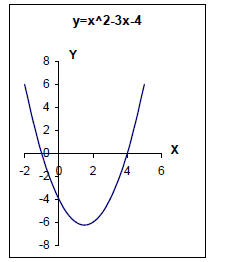Solving Quadratic Equations by Factoring
Quadratic equations are equations (not just
polynomials) of the second-degree, that is, they have
an x2 term in them. Examples are: x2 + x = 5 and x2 – 2x + 35 = 0.
The standard form of a quadratic equation is: ax2 + bx + c = 0.
To solve the quadratic equation x2 + 7x + 6 = 0, we must
find the values of x that make this
equation true. We can do this by factoring.
Factoring a polynomial gives us a product of factors:
x2 + 7x + 6 = (x + 6)(x + 1)
If a product of two numbers equals zero, for example, ab =
0, then either a must equal zero or b
must equal zero (because anything multiplied by zero equals zero), or both may
equal zero. This
is called the principle of zero products.
So, if (x + 6)(x + 1) = 0, then either (x + 6) = 0 or (x +
1) = 0. To solve the original equation, we
solve for x in both of these equations:


The solutions for x2 + 7x + 6 = 0 are –6 and –1.
If the polynomial turns out to be a perfect square, you
only get one solution (or really the same
solution twice):

The solution is x = -3. In this case, both factors will equal zero when x = -3.
Solving a Quadratic Equation
Step 1: Make sure all terms are on
one side of the equation and zero is
on the other side.
a. x2 – 7x = -12 → x2 – 7x + 12 = 0
b. 5x2 = 15x → 5x2 – 15x = 0
c. x(x - 6) = 27 → x(x - 6) – 27 = 0
d. (2x + 5)(x + 9) = 15 → (2x + 5)(x + 9) – 15 = 0
Step 2: If some terms were written
in factored form originally, do all the
multiplication and combine like terms.
c. x(x - 6) – 27 = 0 → x2 – 6x – 27 = 0
d. (2x + 5)(x + 9) – 15 = 0
→ 2x2 + 23x + 45 – 15 = 0
→ 2x2 + 23x + 30 = 0
Step 3: Factor and solve by setting each factor equal to zero:
a. x2 – 7x + 12 = 0

The solutions are x = 3 or x = 4.
b. 5x2 – 15x = 0

The solutions are x = 0 or x = 3.
c. x2 – 6x – 27 = 0

The solutions are x = 9 or x = -3.
d. 2x2 + 23x + 30 = 0

The solutions are x = -3/2 or x = -10.
So why are we doing this?
This section is an introduction to topics in Math 102 – problem solving using
quadratics and
graphing quadratic functions. Quadratic functions are useful when we are trying
to find the
maximum or minimum of a function, such as maximizing area or minimizing cost.
These topics
will be covered later.
The graph of a quadratic function is called a parabola and looks like these:


With what you know now, you can find the x-intercepts of these graphs. The
x-intercepts are
where the graph crosses the x-axis. At these points, y = 0. (In Section 3.2, you
looked at the
y-intercept of straight-line functions - where the line crossed the y-axis. This
concept is similar.)
When you solve a quadratic equation, you are finding the x-intercepts of the
quadratic function
(called finding the “zeros” or “roots”).
For the graphs above:
y = x2 – 3x – 4
y = -2x2 + x + 6
Set y = 0:
0 = x2 – 3x – 4
0 = -2x2 + x + 6
Factor and solve:


Using these values of x, and remembering y = 0, we can state these values as
ordered pairs of
coordinates on a graph in the form (x, y). These represent the points on the
graphs which are the
x-intercepts:
x = -1, y = 0 and x = 4, y = 0
x-intercepts: (-1, 0) and (4, 0)
x = -3/2, y = 0 and x = 2, y = 0
x-intercepts: (-3/2, 0) and (2, 0)
And you can see above, these points are where the graphs cross their x-axes.
Exercises:
Solve, using the principle of zero products:
1. (x + 3)(x + 11) = 0
2.

3. (x – 7)(x + 75)(x – 43) = 0
4. 0.35x (0.1x + 0.4)(0.05x – 15) = 0
Solve by factoring:
5. 9x2 – 16 = 0
6. x2 + 7x = 18
7. 3x2 – 10x – 8 = 0
8. 36x2 +84x + 49 = 0
9. 15x2 +10x = 0
10. (5x + 3)(x – 1) = 13
Find the x-intercepts:
11. y = x2 – 6x + 9
12. y = -3x2 +5x + 2
Answers:
1. x = -3 or –11
2. x = 0 or ¾
3. x = 7 or –75 or 43
4. x = 0 or –4 or 300
5. x = 4/3 or –4/3
6. x = -9 or 2
7. x = -2/3 or 4
8. x = -7/6
9. x = 0 or –2/3
10. x = -8/5 or 2
11. (3, 0)
12. (-1/3, 0), (2, 0)


